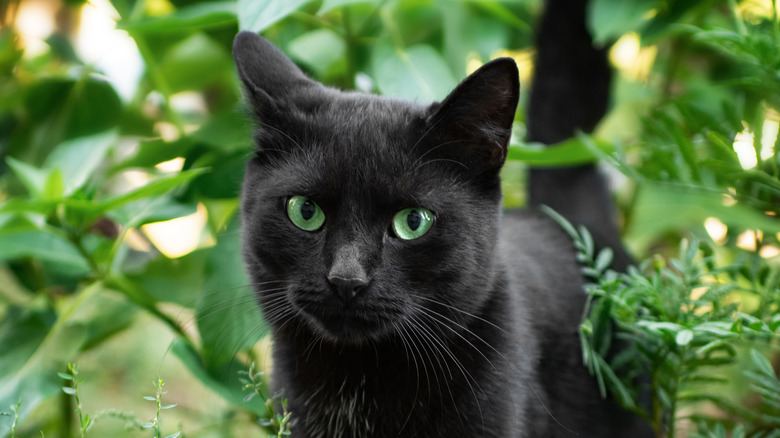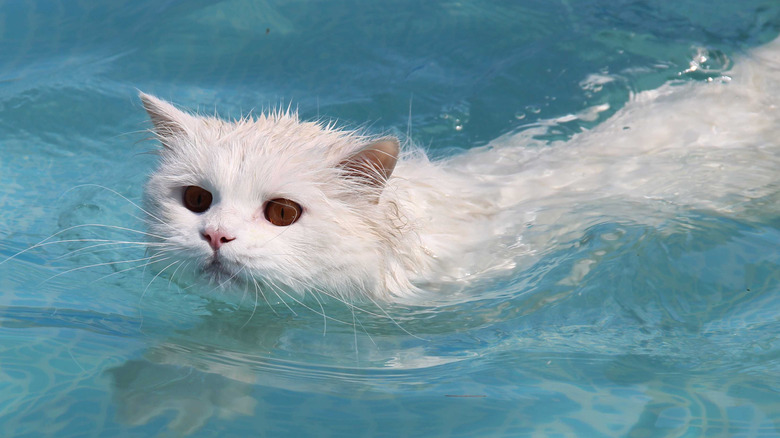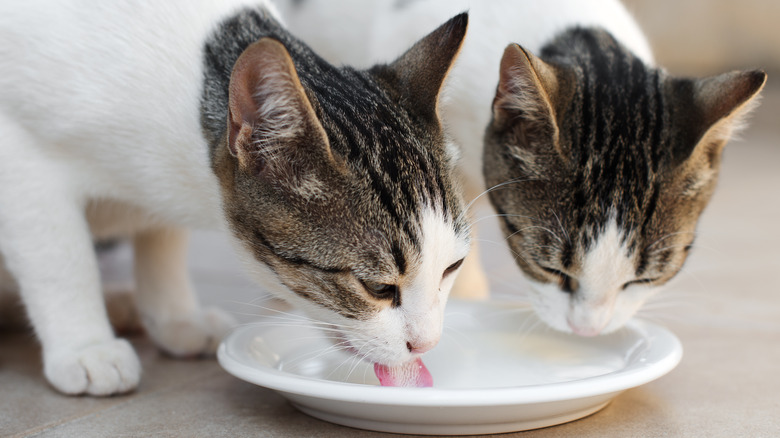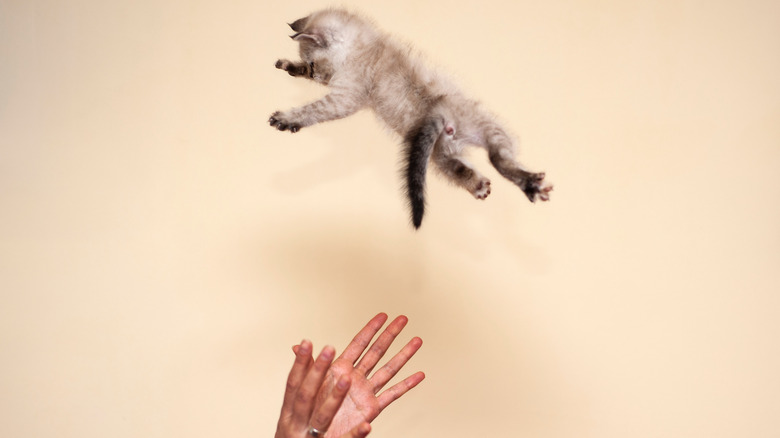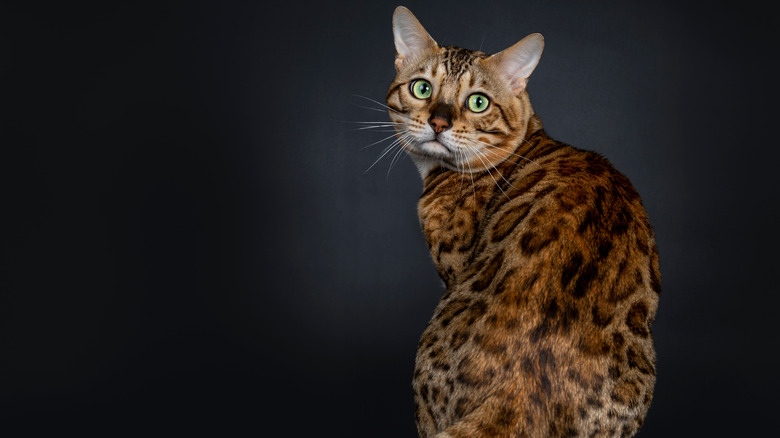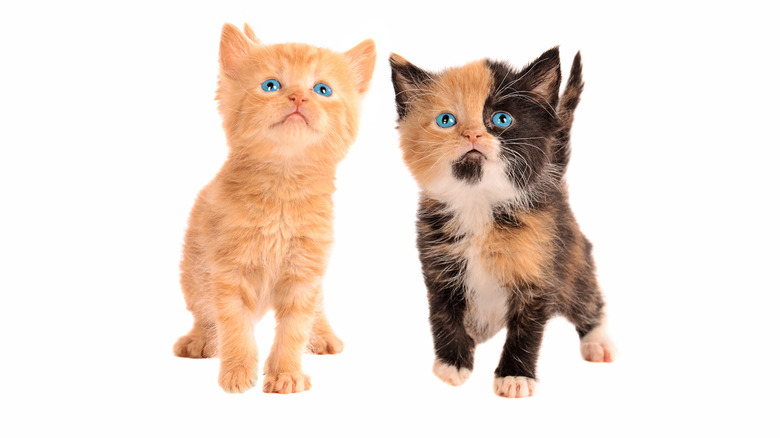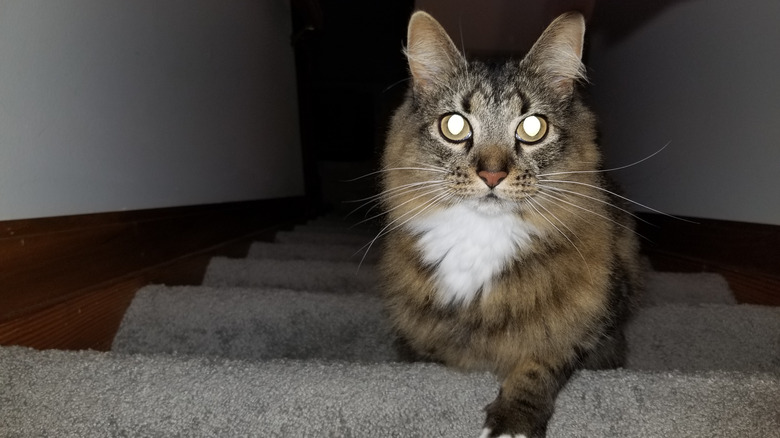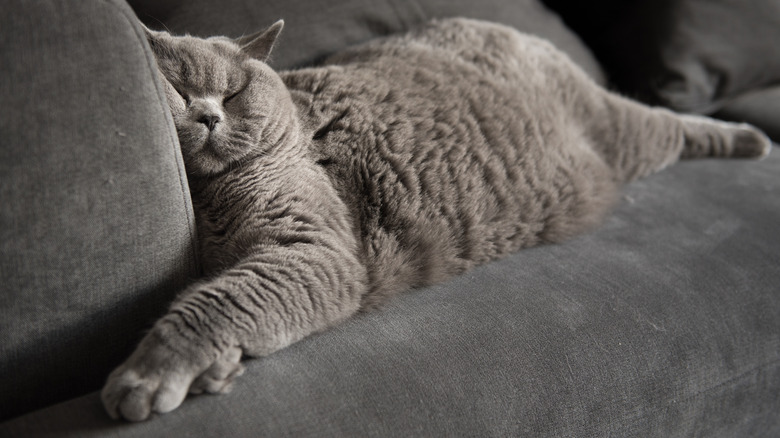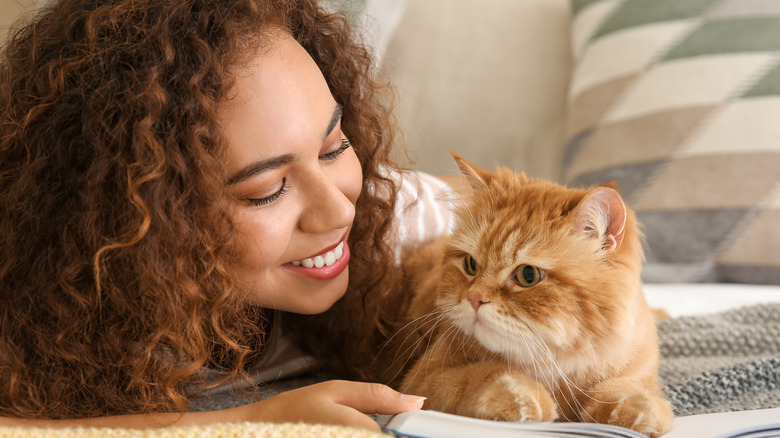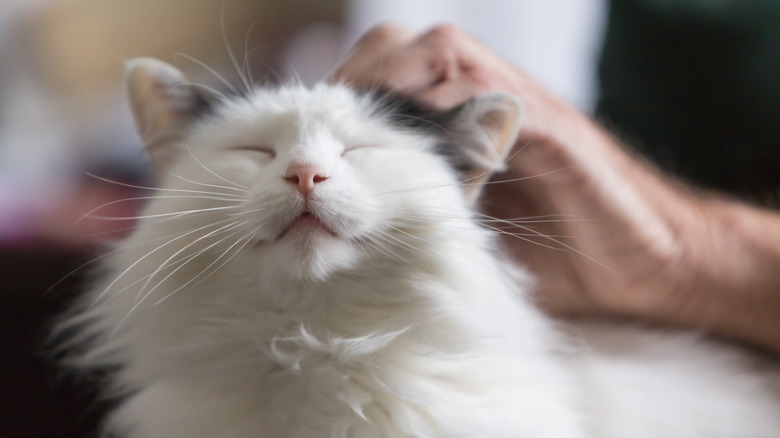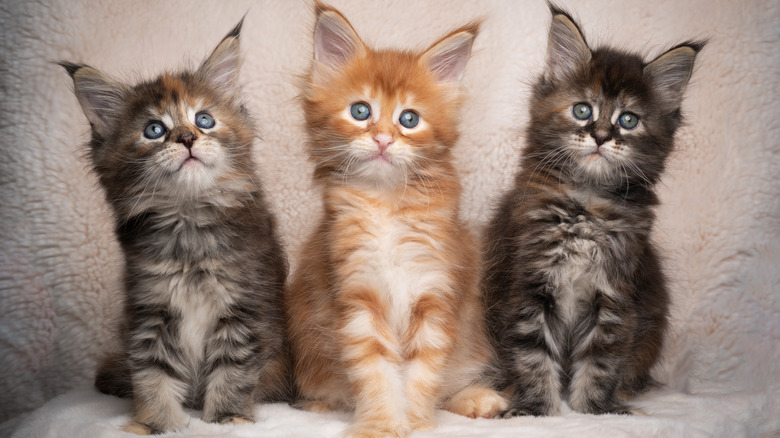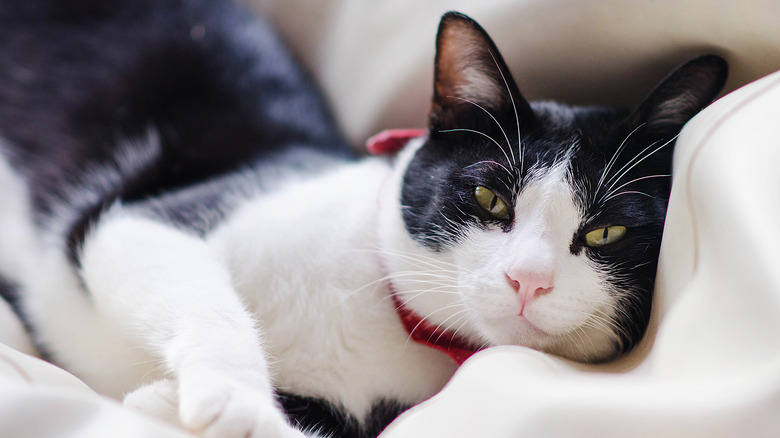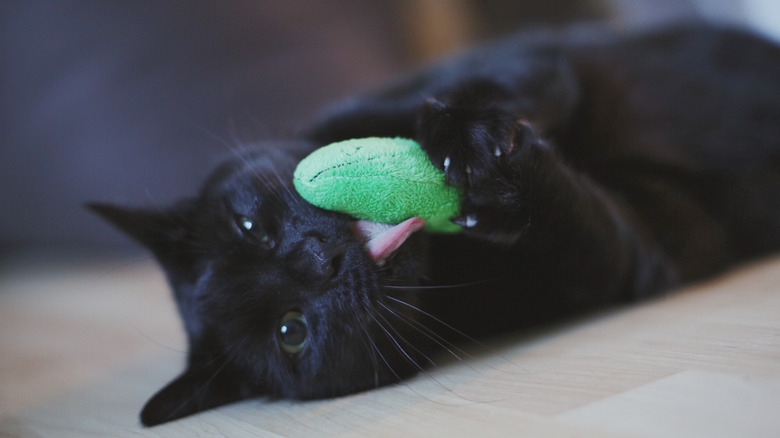False Things Everyone Believes About Cats
Chances are, if you're reading this, that you consider yourself a cat person. You love the furry little purrballs, probably have a few of your own (or more than a few — you know who you are), and you don't mind when your kitty wakes you up at 6 a.m. begging for food. Okay, you do mind, but not too much, as then they snuggle with you afterwards and all is well. So, yes, if you're a cat person, you're in good company, because we are too.
If you've been around cats your entire life, you probably think that you know everything there is to know about felines. However, after doing some digging we discovered that there are actually a lot of myths about cats out there, and many of them are pretty entrenched in our collective perception of these animals. To that end, we're fairly certain that we can surprise you as we bust the myths about our furry familiars. So, without further ado, here are the false things that everyone believes about cats.
Myth: All cats naturally hate water
Have you ever given you cat a bath? Unless you're a cat rapper named MoShow who went viral doing just that on YouTube, we're pretty sure you haven't. After all, cats do a fine job keeping themselves clean, so unless they're a certain breed, they don't need to be washed with soap and water. And, if you were insane enough to try bathing your kitty, you probably ended up covered in scratches because they were not having it. But, does that mean that all cats absolutely hate water, be it in the tub, a pool, or a body of water?
Actually, no — all cats aren't naturally averse to water, according to Purina, though, to be fair, most of them don't like it. That's because they may feel out of control when submerged, or weighed down, or they've had negative experiences with water in the past. However, some breeds of cats — such as Maine Coons, Abyssinians, and Turkish Vans — rather like taking a dip or plunging their paws into a bowl of H2O. Turkish Vans have even been dubbed "the swimming cat" because they enjoy water so much. That's not to say you should toss your cat into the nearest pond, but, if they naturally are inclined to investigate the shower, that's totally normal.
Myth: Cats are unhappy if you keep them indoors
Fewer things make us happier than stumbling across a fluffy cat when we're out on a walk or spending time at the park, and reaching down to give the buddy some pets and scratches. Cats do seem like they're in their happy place when they're outside, as there are tons of creatures to hunt and lots of nature to play in. However, that doesn't mean that cats have to go outside, or that it's mean to keep them indoors all the time — quite the opposite.
As it turns out, if you keep your cat indoors, they're more likely to live longer, as noted by The Humane Society of the United States. That's because they're less likely to get hit by a car, hunted by a predator, or stricken with a parasite or disease if they stay inside — and that, in turn, keeps local wildlife safe from cats, too. Of course, you need to make sure that your floof has adequate stimulation in the form of cat furniture, toys, sunny perches, or even a nice patio that they can lounge on. That way, your feline friends will have everything they need to life a happy life.
Myth: Cats love drinking a nice bowl of milk
If you think that it's totally natural for cats to lap up a delicious saucer filled with milk, we don't blame you — we certainly saw our fair share of cats drinking milk in cartoons and movies growing up, which is probably why this myth got so popular. However, unless your cat is a tiny kitten still drinking from a bottle or suckling its mama, you actually shouldn't be giving your cat milk at all.
Wait a second, you might be saying, as your cat totally loves it when you give them a bowl of the stuff as a treat. However, according to veterinary health expert Dr. Gary Richter, milk is actually quite bad for our feline friends. "Even though some cats can tolerate milk and seem to enjoy it, cow's milk just isn't good for cats," he revealed in an interview with Reader's Digest. "Cats don't need dairy milk, and the potential problems outweigh the potential benefits." Those problems can include vomiting, diarrhea, appetite reduction, and weight changes, as cats are lactose intolerant. Instead? Make sure your cat has access to clean, fresh water, of which they need lots.
Myth: When cats fall, they always land on their paws
Cats really are pretty incredible, as they're super agile and always so graceful when they move. We love how they can stretch out or curl up when they sleep, and how funny they look when they're stalking a toy mouse or a bird high up in the sky. But, one thing that you might have wrong about the way cats move is that when they fall, they don't always land on their feet.
That's not to say that cats don't land perfectly much of the time, as we've certainly seen our cats stick a landing that would make Simone Biles proud. That skill, known as the "righting reflex," is pretty amazing; thanks to their unique system of balance and the structure of their skeleton, cats often manage to get themselves into the ideal position for landing, per Purina. But, if they're too low to the ground when they fall, they might instead land on their side and are more likely to get hurt. However, if they fall from higher up (between seven and 32 floors), kitties are less likely to get hurt, thanks to their slower maximum velocity and body orientation. Pretty wild, huh?
Myth: Cats can't see color, but can see in the dark
One thing is for certain when it comes to cats' eyes: they're all quite beautiful, ranging from green to yellow to blue. We love how they shine in low light, too, and how much feline eyes reflect their little personalities. The myth is that cats don't see colors — they can, though not as many as humans can, as noted by Wired; rather, our feline friends essentially see the world in a similar way that someone who is red-green colorblind does (with just a bit more green). They also have a wider field of vision than humans do, though they don't have as much visual acuity.
Another misconception that we're here to clear up is that cats can't actually see in pitch-black darkness, explains ABC Science. However, they do see exceptionally well in dim light, thanks to the abundance of rod cells in their eyes. The rod cells are also super quick at refreshing themselves, which allows kitties to spot fast motion in the grass that would elude us.
Myth: Orange tabby cats are all male, and calicos are always female
If you have a pet cat that's an orange tabby cat, we want to pet him right now — and we're pretty sure it's a him. And, if you are the proud guardian of a calico kitty, we wouldn't mind snuggling up with her as well, and we'd place our bets that your purrball is a she. However, if you were led to believe that all orange tabby cats are male and all calico cats are female, we have some news for you: that's not the case. According to Be Chewy, for every 80 orange tabbies, there are 20 female tabbies. And, when it comes to calicos, you can come across a male calico or tortoiseshell, though they're rarer at about one in every 3,000.
So what's the mechanism at work here? It all comes down to genetics. First, the scoop on tabbies: the orange trait is carried on the X chromosome and is recessive, so a female cat (XX) would need this recessive trait on both of her X chromosomes. That's why is less common to find orange tabby girl cats. Insofar as the calico situation: you need two X chromosomes to have orange and black in one cat, as a calico does. To that end, male (XY) tortie or calico cats only happen when they have an extra X chromosome (XXY), which is a mutation. These cats are usually sterile, too.
Myth: cats are nocturnal
Cat people have all been there: you're sleeping soundly when all of a sudden, you hear a crash that's indicative that your cat is up to some sort of shenanigans. Or perhaps you've had the delightful experience of being woken up by horfing sounds, meaning there's inevitable cat puke to be cleaned up when daylight rolls around. Maybe these types of events led you to believe that Fluffy is nocturnal — but you'd actually be wrong in that assumption.
So, what's the deal with cats, then? They're actually crepuscular, which means they are most likely to be active around both dawn and dusk, says veterinarian Dr. Michelle Lugones. "These times [are] when the temperatures are the coolest in the desert, which makes it more tolerable to hunt," she revealed in an interview with Reader's Digest. "Hunting at dusk and dawn provides cats some cover because of the darkness, but gives them just enough light to hunt in (for which their eyes are designed)." Well, that explains why your feline friend always wakes you up just before dawn for food, now doesn't it?
Myth: Cats are super lazy, which is why they sleep so much
Speaking of the sleep-wake patterns of cats, you've probably noticed that your cat really likes to sleep — like, a lot. In fact, PetMD estimates that cats sleep for about 15 hours per day on average, and can snooze up to 20 hours during a full-day cycle. However, this isn't just because cats are lazy, though we do wish they would at least help pay the rent. Rather, cats need lots of shuteye to conserve energy for the big hunt, as it is essentially wired into their DNA. And, while our indoor cats have the luxury of getting served cat food instead of catching their dinner, they still may hunt their toy mice or feathers. Oh, and kittens and older cats tend to sleep more than adult cats.
Additionally, when cats sleep, they aren't completely knocked out and dead to the world. Rather, they vacillate between a sort of resting doze (ready to spring into action if they hear a bird chirp or a crunchy bag open), and short periods of deep sleep. Finally, the weather can be a factor in cat sleeping habits, as can their high-protein diets, as noted by Animal Planet.
Myth: Cats are aloof, solitary creatures
Cats have a reputation for being aloof and solitary creatures who don't need their human for anything but food and creature comforts, and do nothing but hiss when they're in the presence of another cat. While it is true that some cats do have these personality traits, they're by no means universal. For one, as animal behavior scientist Kristyn Vitale told The New York Times, "This idea that cats don't really care about people or respond to them isn't holding up." In fact, cats can bond to their human just as babies and dogs do, so they're just as lovable as these more needy creatures.
Additionally, cats are naturally social with one another, as per Merck's Veterinary Manual. They may tend to hunt by themselves, but cat colonies in the wild are matriarchal groups that live together and enjoy playing with one another. Certainly how a cat is socialized is a factor, which is why some are more aloof than others. Out in nature, however, cats co-exist quite nicely.
Myth: Cats whiskers help them stay balanced
One of the neatest aspects of cats is their wiry whiskers, which make them look like dapper little floofballs. Sticking out from the sides of their face for a couple of inches, whiskers help cats with a variety of activities and functions, but helping them stay balanced isn't one of them — even if you've heard differently.
So, if not balance, then what? Well, whiskers help our feline friends measure spaces, help protect sensitive or vulnerable areas of their bodies, assist with their ability to see, and even sense vibrations around them, according to Purina. Additionally, whiskers can provide you with information about how your cat is feeling; if they're relaxed, kitty is relaxed, and if they're pushed forward, kitty is interested in something. However, if they are stiff and in close to their face, your cat may be feeling like there's an immediate threat. What versatile and fascinating things whiskers are!
Myth: A cat's color is indicative of their temperment
We were a little surprised by this myth, but it turns out that a lot of folks think that the color of a cat has something to do with its personality. For example, orange cats have a reputation for being the biggest lovers who love getting tons of affection, and torties are said to have diva-like tendencies. And, of course, there's the ridiculous myth that black cats have supernatural aspects or are harbingers of bad luck. The good news is that absolutely none of this is true!
According to a study conducted by the University of California at Berkeley, no, your white cat isn't aloof because her coat is so pale. "To date, there is little evidence that these perceived differences between differently colored cats actually exist, but there are serious repercussions for cats if people believe that some cat colors are friendlier than others," lead author Mikel Delgado explained. That's why you tend to see black cats spend longer at the shelter than their paler counterparts (via Psychology Today). If there's another more important cat myth that needs to be busted, we're not aware of it!
Myth: Your cat poses a threat to your newborn
Okay, so you just learned that you're going to take the leap and have a baby, and we're so happy for you! Growing your family is a big decision, and we know that there are a lot of things to research and figure out before your bundle of joy arrives. However, if you were thinking of surrendering your cat to the shelter because of your new arrival, we're here to say not so fast. The reason? Cats aren't a danger to babies, no matter what you may have heard.
Thank you Healthline for coming to the rescue on this one! According to the publication, the myth that cats steal a baby's breath is just that, a myth; just be careful to keep kitty and baby apart when the latter is sleeping to avoid accidental suffocation. As for toxoplasmosis, that won't be an issue as long as you keep your cat inside and away from strange cats, change your cat litter carefully and with proper protection, avoid giving your cat raw meat, and keep baby away from the litter box. To avoid contracting cat sicknesses, practice good hygiene, and combat jealousy by respecting your cat's space. Finally, if you're concerned about biting or scratching, just be sure to always supervise baby and kitty together. They could end up being best friends one day, so it's all worth it!
Myth: If a cat is purring, it's because they're happy
Is there anything better than snuggling up with your cat while they purr, purr, purr? We certainly make sure to do exactly this as often as possible, as it makes us happy and keeps us warm and cozy. And yes, there's a good chance that kitty is purring because they're happy and content to be spending quality time with their human. However, just because a cat is purring doesn't necessarily mean that they're saturated in joy.
As it turns out, cats actually purr for a variety of reasons and not just because they're experiencing happiness, as noted by veterinarian Dr. Tony Buffington. "All behavior depends on history, context and expectation," he explained in a chat with Wired. "So it's naive to think that cats can only purr for one reason — it's like thinking that people can only laugh for one reason." So in addition to being content, purring may be an act of self-comforting for cats, which would help them feel better in a stressful environment or an uncomfortable situation. Kitties also purr more intensely when they want food, and it's possible purring can assist in healing, too. Who knew purring was so multi-faceted?
Myth: All cats love getting into catnip
If you're a cat person, then you know one of the most amusing things that your feline friends do is get a little amped up on catnip. It's why we all have a collection of nip-filled toys laying on the floors of our apartments, ready and waiting for a drooling, spazzing kitty to go to work — or play, that is. But, even the most discerning cat guardians might not realize that not all cats are hip to the nip. Think of it like humans and cannabis; not everyone enjoys the stuff.
According to PetMD, approximately 50% to 70% of cats enjoy the effects of catnip, and those can range from getting the crazies to feeling super mellow. That means some kitties just don't react at all, and that's due to genetics — that's right, it's literally in their DNA whether cats enjoy catnip or not. Also, young kittens aged three to six months also don't respond to catnip, so you'll have to wait until they're of age to see which camp your kitten will fall into, per WebMD.
Don't worry if your floof doesn't respond to nip, as there are alternatives that can stimulate them in pleasing ways.
